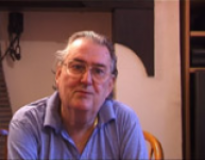Interview 46

Age at interview: 63
Age at diagnosis: 59
Brief Outline: Diagnosed with prostate cancer 1997, brachytherapy 1998.
Background:
More about me...
Explains the process and reason for biopsies.
Explains the process and reason for biopsies.
SHOW TEXT VERSION
PRINT TRANSCRIPT
The sad fact is if they don't find anything in there that's a very limited shot of 6 little stabs with a needle. And they're not massively painful, that are going to make you shoot out of the bed or scream in anguish, you're normally lying on your side and you sort of 'ooh,' it's about, I don't know 1/10th of the pain you'd get from having an injection for a tooth, if you put it on a relative scale, so it's nothing to be terrified of. And they will then take them away and examine those cores. Some places they will mark the cores on a clock face, 'Core 1 was at 12 o clock', others they just take the cores. In my case they didn't note where they'd come from but they did note that 3 of them had 20% cancer and that's what comes back. If they come back and say none of them had cancer it's a shocking thing to think you probably may still have it but they just didn't hit the 3 places where it was because the whole gland is not normally cancerous, it's areas of it.
Considers that treatment should be a personal choice and not affected by lack of public funds.
Considers that treatment should be a personal choice and not affected by lack of public funds.
SHOW TEXT VERSION
PRINT TRANSCRIPT
I believe it should be personal choice of the patient as to whether they have the treatment or not. I don't believe that someone up in the clouds should stand there and say 'You're not going to be tested because I don't believe it's to your value,' you know I believe sitting down here I should be able to say 'Okay I don't want to be tested, I'll take the risk,' but I want to have the knowledge and be able to be tested.
I think anyone over the age of 55 should request a PSA test on an annual medical to see you know what it is and then take advice from there and hopefully in the next 2 years there'll be more information coming out on it in any case.
Describes his experiences of Brachytherapy.
Describes his experiences of Brachytherapy.
SHOW TEXT VERSION
PRINT TRANSCRIPT
How long did it take to get the seeds from America?
Well in my case it was, it was taking 2 months, it has taken longer sometimes I know but 2 months is a reasonable one.
What sort of seeds were they, which ones?
Mine were iodine seeds and they're the only ones that have been used in England, only ones I believe that still are used really in England for this permanent seed implantation. Now this is permanent seed implantation where they put the seed in and it stays with you for the rest of your life although it's, to intents and purposes it stops emitting the radiation after about week 53, the actual seeds, so it's a declining radiation from when it's put in.
After 53 weeks?
Down to 53 weeks yes. The other higher density seeds definitely in 97 could not be imported under the laws of atomic materials so you could only have the iodine ones at the time I went forward for them.
Are the other ones also left in?
They're left in as well. There's a third, there's permanent implantation on one of the two isotopes, the iodine or the P and then there's the high density temporary one where they are put in for may be you know a couple of minutes and pulled out and the next day put in and pulled out again, that's a totally different procedure. And I know there has, there is one that has started up doing that in UK but at the time I had mine done there was only one and it was doing standard Brachytherapy and permanent implantation.
I must stress about the hospital where I did have the Brachytherapy done was that they're a total one off within all the NHS ones I've come across because they weren't NHS and the staff had no clue whether you were private or NHS in there, absolutely no clue, you were treated the same and you were treated brilliantly. And everything was explained from the minute you went in the door, absolutely everything was explained which was the first time it had been to me. And I was talking to an NHS patient in there and he was exactly the same, no difference...
(Laughs) well the seeds are implanted every - - - basically in the perineum. They're inserted on long needles.
Through the perineum?
Yes and you are, you're actually in a stirrup position

